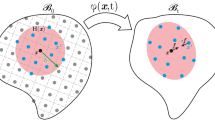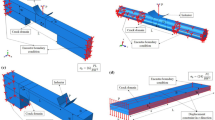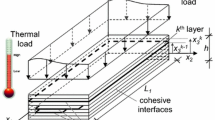Abstract
A reduced order analytical model for peeling of elastic thin films and interface fracture is presented by treating the thin film as a finite length beam with interface interactions accounted for by cohesive zone modeling. The results obtained are shown to be in excellent agreement with finite element simulations and experimental data. Scaling analysis and equations for steady state load and crack length are derived that clearly summarize their parametric dependence.









Similar content being viewed by others
References
Anderson TL (2005) Fracture mechanics: fundamentals and applications, 3rd edn. Taylor & Francis, Boca Raton, FL
Barenblatt GI (1962) The mathematical theory of equilibrium cracks in brittle fracture. Adv Appl Mech 7(1):55–129
Blaysat B, Hoefnagels JP, Lubineau G, Alfano M, Geers MGD (2015) Interface debonding characterization by image correlation integrated with double cantilever beam kinematics. Int J Solids Struct 55:79–91
Chow CL, Woo CW, Sykes JL (1979) On the determination and application of cod to epoxy-bonded aluminium joints. J Strain Anal Eng Des 14(2):37–42
Dugdale DS (1960) Yielding of steel sheets containing slits. J Mech Phys Solids 8(2):100–104
Feraren P, Jensen HM (2004) Cohesive zone modelling of interface fracture near flaws in adhesive joints. Eng Fract Mech 71(15):2125–2142
Gialamas P, Vlker B, Collino RR, Begley MR, McMeeking RM (2014) Peeling of an elastic membrane tape adhered to a substrate by a uniform cohesive traction. Int J Solids Struct 51(18):3003–3011
Gowrishankar S, Mei H, Liechti K, Huang R (2012) A comparison of direct and iterative methods for determining traction–separation relations. Int J Fract 177(2):109–128
Kanninen M (1973) An augmented double cantilever beam model for studying crack propagation and arrest. Int J Fract 9(1):83–92
Li S, Wang J, Thouless MD (2004) The effects of shear on delamination in layered materials. J Mech Phys Solids 52(1):193–214
Li S, Thouless MD, Waas AM, Schroeder JA, Zavattieri PD (2005) Use of mode-I cohesive-zone models to describe the fracture of an adhesively-bonded polymer-matrix composite. Compos Sci Technol 65(2):281–293
Li S, Thouless MD, Waas AM, Schroeder JA, Zavattieri PD (2006) Mixed-mode cohesive-zone models for fracture of an adhesively bonded polymermatrix composite. Eng Fract Mech 73(1):64–78
Mohammed I, Liechti KM (2000) Cohesive zone modeling of crack nucleation at bimaterial corners. J Mech Phys Solids 48(4):735–764
Na SR, Sarceno DA, Liechti KM (2016) Ultra long-range interactions between silicon surfaces. Int J Solids Struct. 80:168–180
Parmigiani JP, Thouless MD (2007) The effects of cohesive strength and toughness on mixed-mode delamination of beam-like geometries. Eng Fract Mech 74(17):2675–2699
Parvin M, Knauss WG (1990) Damage induced constitutive response of a thermoplastic related to composites and adhesive bonding. Int J Fract 42(1):57–72
Prandtl L (1933) Ein gedankenmodell fr den zerreivorgang sprder krper. ZAMM J Appl Math Mech 13(2):129–133
Prandtl L, Knauss WG (2011) A thought model for the fracture of brittle solids. Int J Fract 171(2):105–109
Stigh U (1988) Damage and crack growth analysis of the double cantilever beam specimen. Int J Fract 37(1):R13–R18
Thouless MD, Yang QD (2008) A parametric study of the peel test. Int J Adhes Adhes 28(45):176–184
Ungsuwarungsri T, Knauss WG (1987) The role of damage-softened material behavior in the fracture of composites and adhesives. Int J Fract 35(3):221–241
Wei Y, Hutchinson J (1998) Interface strength, work of adhesion and plasticity in the peel test. Int J Fract 93(1–4):315–333
Williams JG (1989) End corrections for orthotropic DCB specimens. Compos Sci Technol 35(4):367–376
Williams JG, Hadavinia H (2002) Analytical solutions for cohesive zone models. J Mech Phys Solids 50(4):809–825
Acknowledgments
The authors gratefully acknowledge financial support from the National Science Foundation Nanosystems Engineering Research Center on Nanomanufacturing Systems for Mobile Computing and Mobile Energy Technologies (NASCENT)—NSF EEC Grant No. 1160494.
Author information
Authors and Affiliations
Corresponding author
Rights and permissions
About this article
Cite this article
Jain, S., Na, S.R., Liechti, K.M. et al. Characteristic scaling equations for softening interactions between beams. Int J Fract 201, 1–9 (2016). https://doi.org/10.1007/s10704-016-0106-x
Received:
Accepted:
Published:
Issue Date:
DOI: https://doi.org/10.1007/s10704-016-0106-x




